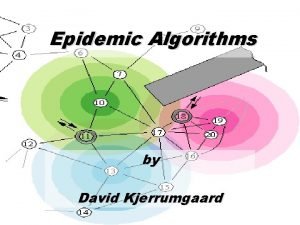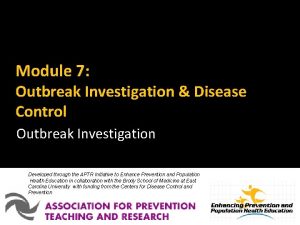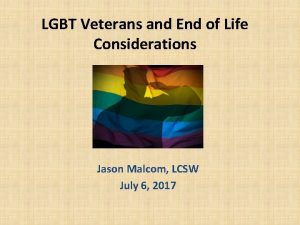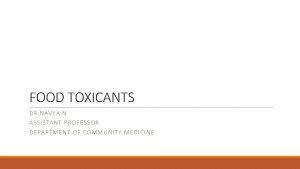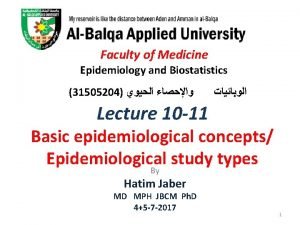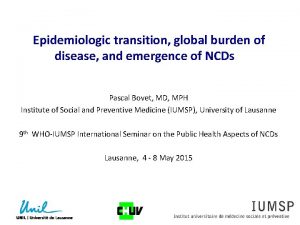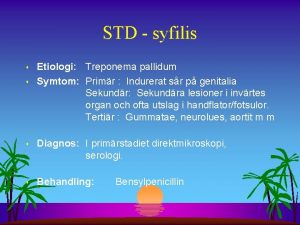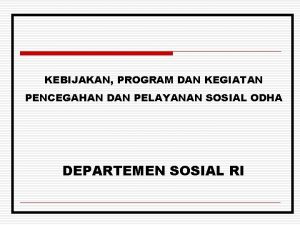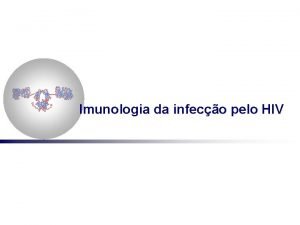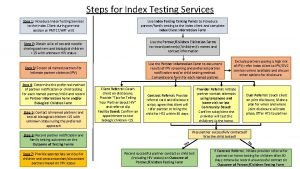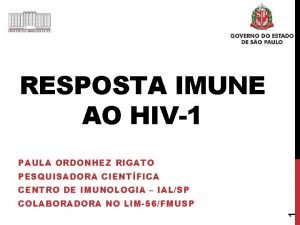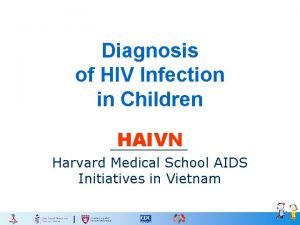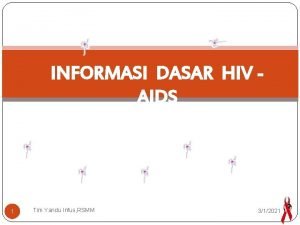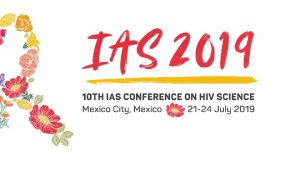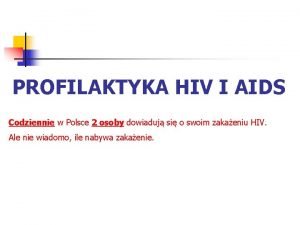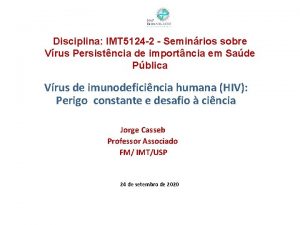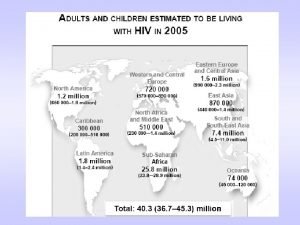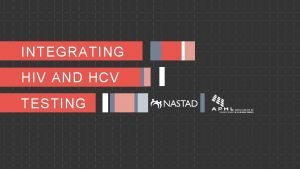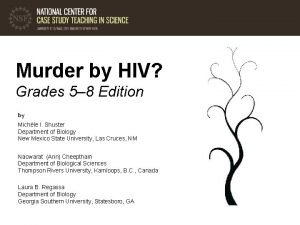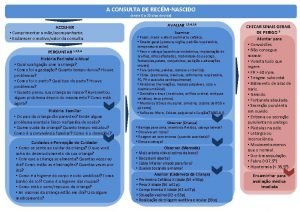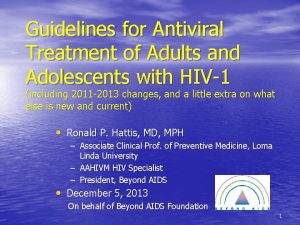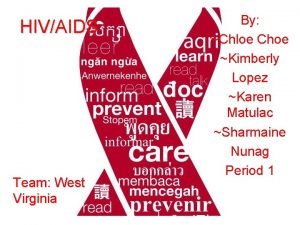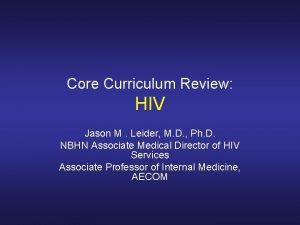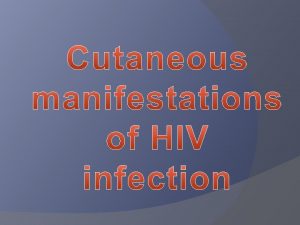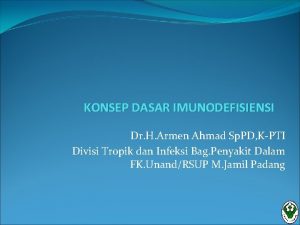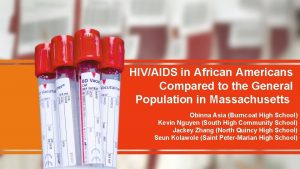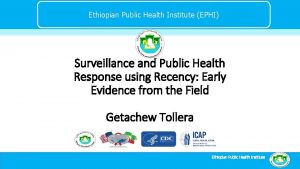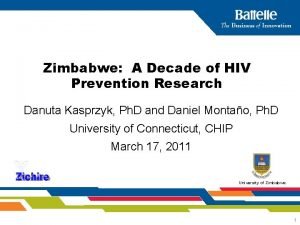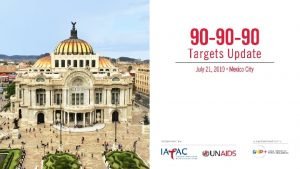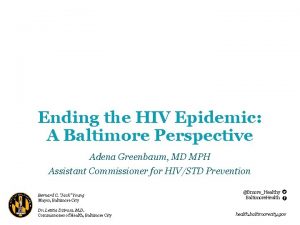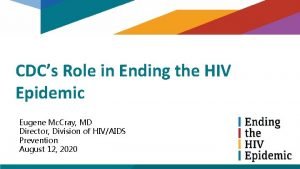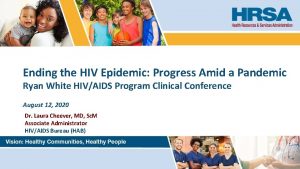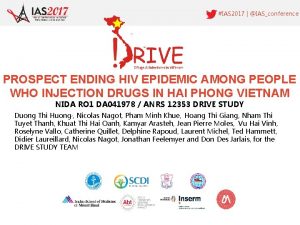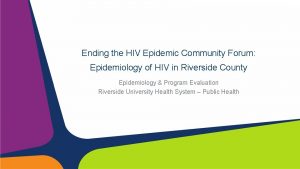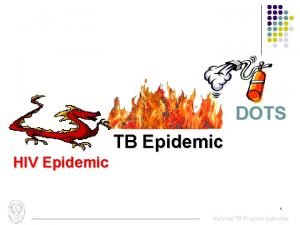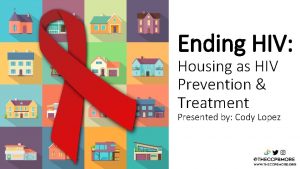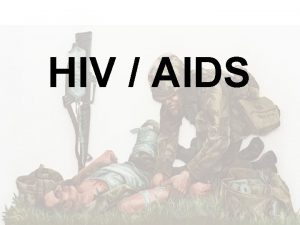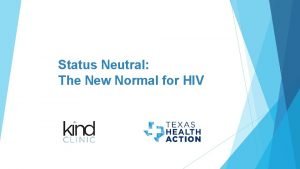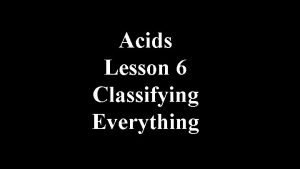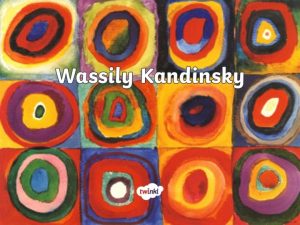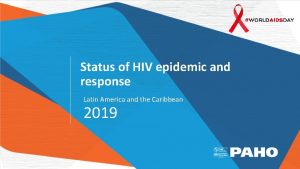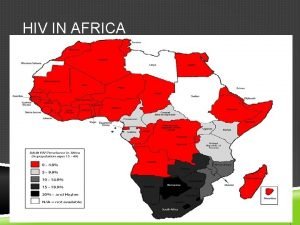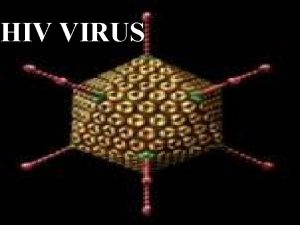Status Neutral Approach to Ending the HIV Epidemic










































- Slides: 42


Status Neutral Approach to Ending the HIV Epidemic in New York City Demetre Daskalakis, MD, MPH Deputy Commissioner, Disease Control Department of Health and Mental Hygiene @Dr. Demetre Share your thoughts on this presentation with #IAS 2019

NEW YORK ENDING THE HIV EPIDEMIC: SCIENCE + COMMUNITY + POLITICAL WILL

Ending the Epidemic (Et. E): A Recipe Science Community Political Will

What Does Ending the Epidemic Mean? § Identify persons with HIV who remain undiagnosed and link them to health care. § Link and retain persons diagnosed with HIV in health care to maximize viral suppression so they remain healthy and prevent further transmission. § Facilitate access to Pre-Exposure Prophylaxis (Pr. EP) for HIV negative persons at risk of exposure. D. Holtgrave

Creating The Blueprint § Recommendations solicited from the Community § October 2014: Task Force Convened § December 2014: Task force meetings to generate recommendations completed § Unanimous Agreement of All Members § January 2015: Blueprint released

HIV is an Emergency: Treat it That Way! Summary of the global HIV epidemic (2017) Source: UNAIDS/WHO estimates

HIV is an Emergency: Treat it That Way! CDC Estimated Lifetime Risk of HIV

ENDING THE EPIDEMIC: OUR STRATEGY TO END HIV IN NEW YORK CITY


Increase Access to HIV Prevention Services Increase awareness and uptake of HIV prevention services, including Pr. EP and post-exposure prophylaxis (PEP). Initiatives include:

Increase Access to HIV Prevention Services Increase awareness and uptake of HIV prevention services, including Pr. EP and post-exposure prophylaxis (PEP). Initiatives include: Play. Sure Network, a citywide network of HIV testing sites, community-based organizations, and clinics that promote patientspecific approaches to sexual health and HIV prevention, increase access to Pr. EP and PEP, and link people who test positive for HIV to care

Increase Access to HIV Prevention Services Increase awareness and uptake of HIV prevention services, including Pr. EP and post-exposure prophylaxis (PEP). Initiatives include: PEP Centers of Excellence and a 24 -hour PEP hotline

Increase Access to HIV Prevention Services Increase awareness and uptake of HIV prevention services, including Pr. EP and post-exposure prophylaxis (PEP). Initiatives include: Clinical sites engaging adolescents at risk for HIV in biomedical prevention and support services

Increase Access to HIV Prevention Services Increase awareness and uptake of HIV prevention services, including Pr. EP and post-exposure prophylaxis (PEP). Initiatives include: Sexual health marketing campaigns, including “Living Sure, ” which promotes Pr. EP among cisgender and transgender women, and “¡Listos!”, which promotes Pr. EP, PEP, and treatment adherence among Latinos and is the Health Department’s first campaign conceived of and principally released in Spanish

Increase Access to HIV Prevention Services Increase awareness and uptake of HIV prevention services, including Pr. EP and post-exposure prophylaxis (PEP). Initiatives include: Pr. EP and PEP detailing campaigns involving highly trained, full-time teams conducting one-on-one educational visits with providers, with the latest cycle focusing on women’s health care providers

Increase Access to HIV Prevention Services Increase awareness and uptake of HIV prevention services, including Pr. EP and post-exposure prophylaxis (PEP). Initiatives include:

Promote Optimal Treatment for All New Yorkers Living with HIV Link people newly diagnosed with HIV and those who have fallen out of care to antiretroviral treatment, partner services, and support services to improve health outcomes and viral suppression. Initiatives include:

Promote Optimal Treatment for All New Yorkers Living with HIV Link people newly diagnosed with HIV and those who have fallen out of care to antiretroviral treatment, partner services, and support services to improve health outcomes and viral suppression. Initiatives include: The Undetectables program, which combines social marketing with a toolkit of evidence-based adherence supports, including patient-centered care planning and financial incentives for achieving viral suppression

Promote Optimal Treatment for All New Yorkers Living with HIV Link people newly diagnosed with HIV and those who have fallen out of care to antiretroviral treatment, partner services, and support services to improve health outcomes and viral suppression. Initiatives include: Promotion of the evidence-based finding that people with HIV who maintain an undetectable viral load for at least six months do not transmit HIV through sex – also known as “Undetectable equals Untransmittable” or “U = U”

Promote Optimal Treatment for All New Yorkers Living with HIV Link people newly diagnosed with HIV and those who have fallen out of care to antiretroviral treatment, partner services, and support services to improve health outcomes and viral suppression. Initiatives include:

Achieve Sexual Health Equity for All New Yorkers Promote comprehensive, affirming sexual health care for all New Yorkers and support community-driven programs focused on those disproportionately affected by HIV. Initiatives include:

Achieve Sexual Health Equity for All New Yorkers Promote comprehensive, affirming sexual health care for all New Yorkers and support community-driven programs focused on those disproportionately affected by HIV. Initiatives include: Creation and promotion of the LGBTQ Health Care Bill of Rights to empower LGBTQ patients to seek optimal care

Achieve Sexual Health Equity for All New Yorkers Promote comprehensive, affirming sexual health care for all New Yorkers and support community-driven programs focused on those disproportionately affected by HIV. Initiatives include: LGBTQ Health Equity Coalition, a group of nonprofit and governmental organizations, community members, and allies committed to advancing the health of LGBTQ New Yorkers through the collective impact of novel partnerships

Achieve Sexual Health Equity for All New Yorkers Promote comprehensive, affirming sexual health care for all New Yorkers and support community-driven programs focused on those disproportionately affected by HIV. Initiatives include: Technical assistance and support to transgender and gender nonconforming-led communitybased, grassroots organizations to build their capacity to serve their communities

Achieve Sexual Health Equity for All New Yorkers Promote comprehensive, affirming sexual health care for all New Yorkers and support community-driven programs focused on those disproportionately affected by HIV. Initiatives include: Re-Charge, an HIV status neutral, sex-positive, and nonjudgmental harm reduction program for men who have sex with men and individuals of trans experience who have sex with men and who use crystal methamphetamine

Achieve Sexual Health Equity for All New Yorkers Promote comprehensive, affirming sexual health care for all New Yorkers and support community-driven programs focused on those disproportionately affected by HIV. Initiatives include:

The NYC ETE Plan at the Health Department’s Sexual Health Clinics The Health Department’s eight Sexual Health Clinics provide low-to-no cost walk-in services to anyone 12 years of age or older, regardless of ability to pay, insurance coverage, or immigration status. No parental consent is necessary.

The NYC ETE Plan at the Health Department’s Sexual Health Clinics The Health Department’s eight Sexual Health Clinics provide low-to-no cost walk-in services to anyone 12 years of age or older, regardless of ability to pay, insurance coverage, or immigration status. No parental consent is necessary. Sexually transmitted infection services: Testing and onsite treatment for syphilis, gonorrhea, chlamydia, and other sexually transmitted infections; “express visit” testing for asymptomatic patients, partner services, and expedited partner therapy for chlamydia

The NYC ETE Plan at the Health Department’s Sexual Health Clinics The Health Department’s eight Sexual Health Clinics provide low-to-no cost walk-in services to anyone 12 years of age or older, regardless of ability to pay, insurance coverage, or immigration status. No parental consent is necessary. HIV Services: Testing and same-day Jumpst. ART treatment initiation for persons testing positive for HIV, PEP and Pr. EP initiation and referral, linkage to care, and partner services

The NYC ETE Plan at the Health Department’s Sexual Health Clinics The Health Department’s eight Sexual Health Clinics provide low-to-no cost walk-in services to anyone 12 years of age or older, regardless of ability to pay, insurance coverage, or immigration status. No parental consent is necessary. Immunizations: Human papilloma virus, hepatitis A, hepatitis B, and meningococcal vaccines

The NYC ETE Plan at the Health Department’s Sexual Health Clinics The Health Department’s eight Sexual Health Clinics provide low-to-no cost walk-in services to anyone 12 years of age or older, regardless of ability to pay, insurance coverage, or immigration status. No parental consent is necessary. Behavioral health services: Screening and interventions for substance use and short-term counseling and support for other behavioral health needs

The NYC ETE Plan at the Health Department’s Sexual Health Clinics The Health Department’s eight Sexual Health Clinics provide low-to-no cost walk-in services to anyone 12 years of age or older, regardless of ability to pay, insurance coverage, or immigration status. No parental consent is necessary. Contraceptive services: Emergency contraception and birth control, including pills, patches, rings, and Depo-Provera injection

The NYC ETE Plan at the Health Department’s Sexual Health Clinics The Health Department’s eight Sexual Health Clinics provide low-to-no cost walk-in services to anyone 12 years of age or older, regardless of ability to pay, insurance coverage, or immigration status. No parental consent is necessary. Harm reduction services: Narcan kits and syringe dispensing

The NYC ETE Plan at the Health Department’s Sexual Health Clinics The Health Department’s eight Sexual Health Clinics provide low-to-no cost walk-in services to anyone 12 years of age or older, regardless of ability to pay, insurance coverage, or immigration status. No parental consent is necessary.

NEW YORK CITY EPIDEMIOLOGY & BACKGROUND

HIV Epidemiology and Field Services Program. HIV Surveillance Annual Report, 2017. New York City Department of Health and Mental Hygiene: New York, NY. December 2018

New HIV Diagnoses – NYC 2017 80% 70% 60% 50% 40% 30% 20% 10% Gender Race/ Ethnicity Source: NYC DOHMH, Bureau of HIV Surveillance Data *MSM=Men who have sex with men, TG- Age Borough 0% ) Ve (20<3 ry 0 Hi gh %) (≥ 30 % ) ) <2 0% 0 - Hi gh (1 (< 1 um w Lo M ed i He te ID ro U se xu al -S C TG SM M d an Isl ns ee te n ta n lyn ha t Qu St a Tr M an ok on x Br o Br + 50 9 -4 9 40 30 -3 9 -2 0 20 <2 I AP tin o W hi te La ck Bl a e en de r al sg an Fe m M al e 0% Transmission Poverty (area-based, % below FPL) Risk*

New HIV diagnoses and estimated incident HIV infections 1, NYC 2013 -20172 2, 898 Number of HIV cases 3, 000 2, 805 2 2, 500 2, 800 2, 494 2, 800 2, 276 2, 600 2, 157 2, 200 2, 000 1, 800 1, 500 Estimated number of HIV cases 3, 500 Trends in estimated incident HIV infections 1 by sex at birth and transmission risk, NYC 2013 -20172 2, 200 2, 000 1, 800 1, 600 1, 400 1, 200 1, 000 800 600 1, 000 400 500 0 2013 2014 2015 2016 2017 Year of diagnosis New Diagnoses of HIV Estimated incident HIV infections 2013 2014 2015 2016 2017 MSM Heterosexual female Heterosexual male MSM-IDU Female IDU Male IDU Estimated HIV incidence overall and by transmission risk group declined in NYC between 2013 and 2017. HIV Epidemiology and Field Services Program. HIV Surveillance Annual Report, 2017. New York City Department of Health and Mental Hygiene: New York, NY. December 2018 MSM=Men who have sex with men; IDU=Injection drug use history. 1 Using the method in: Song R, et al. Using CD 4 data to estimate HIV incidence, prevalence, and percent of undiagnosed infections in the United States. J Acquir Immune Defic Syndr 2017; 74(1): 3 -9. 22017 incidence estimates are preliminary.

4000 3500 Achieving ETE GOALS: New HIV Diagnoses and Estimated Incident HIV Infections in NYC, 2010 -2020 3490 3300 3374 Total new HIV diagnoses 3400 Estimated incident HIV infections 3119 3100 2898 3000 2000 1500 2805 2800 2494 Number of HIV cases 2500 2800 2600 2276 2200 2157 1800 1941 1650 1350 945 1000 600 500 0 2011 2012 2013 2014 Actual Data Numbers of new HIV diagnoses from 2010 to 2017 were reported to NYC DOHMH as of March 31, 2018. Estimated incident HIV infections from 2010 to 2017 were calculated using CDC’s “CD 4 -depletion model, ” which uses distribution of CD 4 count at HIV diagnosis to estimate timing of HIV infection. All data from 2018 to 2020 are projections based on an estimated acceleration of historical declines. Year 2015 2016 2017 2018 2019 Projection 2020

What does this all mean? • We are diagnosing prevalent HIV infections at a stable rate earlier and more efficiently – Proportion of acute infections detected increasing – Diagnosis at earlier stage of infection, before people get ill. 17. 5 % concurrent AIDS • Decreasing incidence means that people are not getting HIV – U=U continues to work – Pr. EP in MSM is likely driving down transmission • Areas we are working to improve – Pr. EP in cis Women and TGNC People – Latino MSM- ¡Listos! and more! NYC IS ON TRACK FOR 2020!

THANK YOU!
 David kjerrumgaard
David kjerrumgaard Endemic epidemic
Endemic epidemic Toxinq
Toxinq Aids epidemic
Aids epidemic Epidemic dropsy
Epidemic dropsy Endemic epidemic
Endemic epidemic Doctors attributed the epidemic to the rampant
Doctors attributed the epidemic to the rampant Epidemiological transition
Epidemiological transition Multiple approach avoidance conflict
Multiple approach avoidance conflict Virtual circuit network and datagram network
Virtual circuit network and datagram network Bandura's reciprocal determinism
Bandura's reciprocal determinism Theoretical models of counseling
Theoretical models of counseling What is a research
What is a research Waterfall market entry strategy
Waterfall market entry strategy Deep learning approach and surface learning approach
Deep learning approach and surface learning approach Approach to system development
Approach to system development Syntom på klamydia
Syntom på klamydia Kasus hiv aids
Kasus hiv aids Hiv
Hiv Steps of index testing
Steps of index testing Imune
Imune Hiv meaning
Hiv meaning Virus hiv
Virus hiv Hiv test window period
Hiv test window period Procentowe ryzyko zakażenia hiv
Procentowe ryzyko zakażenia hiv Hiv
Hiv Chapter 24 sexually transmitted diseases and hiv/aids
Chapter 24 sexually transmitted diseases and hiv/aids Ciclo do hiv
Ciclo do hiv Ciclo vitale hiv
Ciclo vitale hiv Window period hiv
Window period hiv Hiv
Hiv Murder by hiv
Murder by hiv Quang trung
Quang trung Hiv patologia
Hiv patologia Hiv symptoms
Hiv symptoms Hiv lifecycle
Hiv lifecycle Aids symptoms
Aids symptoms Hiv
Hiv Causative organism of hiv/aids
Causative organism of hiv/aids Stadium hiv
Stadium hiv Hiv risk factors
Hiv risk factors Ephi ethiopia
Ephi ethiopia Hiv in adults
Hiv in adults
